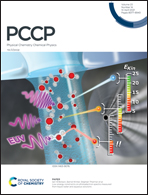Phase separation of binary mixtures induced by soft centrifugal fields†
Abstract
We use the model system ethanol–dodecane to demonstrate that giant critical fluctuations induced by easily accessible weak centrifugal fields as low as 2000g can be observed above the miscibility gap of a binary liquid mixture. Moreover, several degrees above the phase transition, i.e. in the one-phase region, strong gradients of ethanol concentration occur upon centrifugation. In this case, the standard interpretation of sedimentation equilibrium in the analytical ultracentrifuge (AUC) yields an apparent molar mass of ethanol three orders of magnitude higher than the real value. Notably, these composition gradients have no influence on the distribution gradient of solutes such as dyes like Nile red. The thick opaque interphase formed upon centrifugation does not appear as the commonly observed sharp meniscus, but as a turbidity zone, similar to critical opalescence. This layer is a few millimeters thick and separates two fluids with low compositional gradients. All these effects can be qualitatively understood and explained using the Flory–Huggins solution model coupled to classical density functional theory (DFT). In this domain hetero-phase fluctuations can be triggered by gravity even far from the critical point. Taking into account Jean Perrin's approach to external fields in colloids, a self-consistent definition of the Flory effective volume and an explicit calculation of the total free energy per unit volume is possible.



 Please wait while we load your content...
Please wait while we load your content...